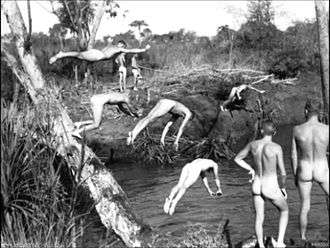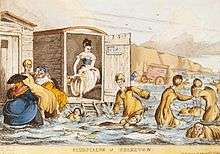Nude swimming
Nude swimming, or skinny dipping, is the practice of bathing naked, whether in natural bodies of water, in swimming pools, or in hot tubs.

The term skinny-dip was first recorded in English in 1947.[1]
History
1400s–1600s
England
In 1449, the Bishop of Bath and Wells, Thomas Beckynton, issued the following "injunction and order to the archdeacon of Bath and his official, and all the rectors, vicars and chaplains of the city and archdeaconry of Bath":

On a report which has reached the ears of the bishop that the heavenly gift of warm and healing waters with which the city of Bath has been endowed from of old is turned into an abuse by the shamelessness and uncleanness of the people of that city, insomuch that, when any persons, whether male or female, go to the said waters to bathe and recover their health, and through modesty and shame try to cover their privy parts, the men with drawers (femoralibus) and the women with smocks (subunculis), they, the said people, by what they say is an established custom of the city, barbarously and shamelessly strip them of their said garments and reveal them to the gaze of the bystanders, and inflict on them not only the loss of their garments but a heavy monetary fine, - during mass on Sundays, solemn days and feast days, to admonish all the citizens of Bath, and all others staying there, that they abstain from such excesses under penalty of the greater excommunication, and to enjoin on them, under a like penalty, that henceforth no males or females who have reached puberty go to the baths without wearing such drawers and smocks or other linen garments.[2]
The woodcut illustrations in Everard Digby's 1587 book The Art of Swimming (De Arte Natandi) and later, the 40 copperplate etchings in Melchisédech Thévenot's 1696 instruction book, also called The Art of Swimming, illustrate that swimming was normally costume free.[3][4]
Thomas Guidott set up a medical practice in the English town of Bath in 1668. He became interested in the curative properties of the waters. In 1676, he wrote A discourse of Bathe, and the hot waters there. Also, Some Enquiries into the Nature of the water. This brought the health-giving properties of the hot mineral waters to the attention of the aristocracy.[5] Doctors and quacks set up spa towns such as Harrogate, Bath, Matlock and Buxton soon after taking advantage of mineral water from chalybeate springs.[6]
1700s
England
By 1709, working people had been visiting the coast to be 'dipped' for health or to 'bathe' for leisure for 'some time'.[7] In 1709, a man from Crosby had his daughters dipped in the sea to cure a skin complaint.[8] The Bath Corporation official bathing dress code of 1737 prohibited men and women to swim nude either in the day or in the night. Bath's specific rules were prescribed as follows:
It is Ordered Established and Decreed by this Corporation that no Male person above the age of ten years shall at any time hereafter go into any Bath or Baths within this City by day or by night without a Pair of Drawers and a Waistcoat on their bodies. And that no Female person shall at any time hereafter go into a Bath or Baths within this City by day or by night without a decent Shift on their bodies. And that no Man Guide shall at any time hereafter go into any Bath or Baths within this City by day or by night without a pair of drawers and a waistcoat on their bodies and that each Guide shall wear a Cap with a Tassel to it to distinguish them from the people upon pain that every one offending therein to forfeit and loose for each offence the sum of 3S. 4d. of current money of Great Britain to be paid to the Chamberlain of the said City for the time being within three days next after each offence shall be committed to and for the use of the Poor of the said City.[2]
In the early 1730s, fashionable sea bathing initially followed the inland health seeking tradition.[9] Sea bathing resorts modelled themselves on Bath, and provided promenades, circulating libraries and assembly rooms.[8] While sea bathing or dipping, men and boys were naked. Women and girls were encouraged to dip wearing loose clothing. Scarborough was the first resort to provide bathing machines for changing. Some men extended this to swimming in the sea and by 1736 it was seen at Brighton and Margate, and later at Deal, Eastbourne and Portsmouth.[9]
In England, bathing in the sea by the lower classes was noted in Southampton by Thomas Gray in 1764, and in Exmouth in 1779.[10] In Lancashire, working women and men bathed naked in the sea together in 1795: "Lower classes of people of both sexes made an annual pilgrimage to Liverpool where they dabbled in the salt water for hours at each tide in promiscuous numbers and not much embarrassing themselves about appearance."[10]
1800s
England

At the beginning of the Victorian period in England, men and boys typically swam naked in the sea near bathing machines that were used by women. There were some efforts to designate separate beach sections for males and females.[11] On the River Cherwell near the University of Oxford, an area for male nude bathing was known as Parson's Pleasure; a nearby area for female nude bathing which closed in 1970 was known as Dame's Delight.[12][13]
In the latter half of the 19th century, the rise of the influence of Christian Evangelicals caused arrangements for mixed bathing to be reassessed. Moral pressures led some town councils to establish zones for the women and men to bathe separately. These areas were not policed; mixed bathing was a popular activity. Resorts attempted to placate the Evangelicals without upsetting traditional bathers.[14] There are very few records of magistrates enforcing the bylaws. In 1895 Cosmopolitan reported: "At most English resorts, buff bathing is available before eight o'clock in the morning"[15] while Brighton, Worthing, Hastings, Bexhill, Bognor and Folkestone still tolerated nude bathing at any time of the day, in areas away from the central bathing areas.[15]
Drawers, or caleçons as they were called (fr:caleçon de bain), came into use in the 1860s. Even then there were many who protested against them and wanted to remain in the nude. Rev. Francis Kilvert, an English nude swimmer, described men's bathing suits coming into use in the 1870s as "a pair of very short red and white striped drawers". Excerpts from Kilvert's diary show the transition in the England of the 1870s from an acceptance of nude bathing to the acceptance of bathing suits. Kilvert describes "a delicious feeling of freedom in stripping in the open air and running down naked to the sea."[16]
In 1895, The Daily Telegraph, Standard, Daily Graphic and Daily Mail newspapers ran a campaign to reintroduce mixed bathing in all resorts, pointing out that its prohibition split up families and encouraged them to take their holidays abroad. Commercial pressure defeated the moral pressures. Sea bathing had ceased to be done for health reasons, and was done overwhelmingly for pleasure. As the segregated beaches in town disappeared, bathing costumes for men became part of the commercial package, and nude bathing ceased.[17]

The introduction of mixed bathing throughout Europe and elsewhere certainly created pressure towards bathing costumes being worn by both genders. However, well into the latter days of the Victorian Era, whereas all females were routinely wearing modest bathing attire, many boys well into their teens in Victorian England, even when in a mixed gender setting, were still swimming and playing at the beach resorts completely naked. An article published on August 23, 1891 in the Syracuse Sunday Herald suggests naked boys of up to 15 years in age were problematic for American parents with daughters, and read:
A 'Bewildered American' writes to the London Standard that he can't take his little girl to play in the sand at a British seaside resort without her being surrounded by crowds of naked boys. An English friend told him that they let their daughters play with naked boys of ten years of age, but draw the line at fifteen.[18]
South Africa
From 1873, the East London, Eastern Cape town council promulgated measures to control swimming hours, apparel and especially separate swimming areas for men and women. These regulations were too conservative and constraining for the taste of the residents of this coastal town and for several decades they were the subject of legal battles, or were simply ignored. The dispute was finally settled in 1906 when mixed bathing was permitted with the proviso that both men and women should wear suitable swimming costumes.[19]
United States
U.S. president John Quincy Adams was known to skinny-dip.[20]
In the United States, skinny dipping by boys was common. The Dixon, Illinois Evening Telegraph 1890 published a request: "for boys swimming in the mill race to be more modest as women felt they can't go down Water Street for fear of seeing them."[21]
1900s
 Swim class for boys, England, c. 1914
Swim class for boys, England, c. 1914 Naked boys, clothed girls in Trafalgar Square, c. 1912
Naked boys, clothed girls in Trafalgar Square, c. 1912 Two nude boys walking down road to swimming hole - 1919
Two nude boys walking down road to swimming hole - 1919
England
In some English schools (Manchester Grammar School, for example), nude swimming was compulsory until the 1970s. It was discontinued when the school began admitting female students.[22]
United States
American president Theodore Roosevelt described nude swims in the Potomac with his "tennis cabinet" in his Autobiography: "If we swam the Potomac, we usually took off our clothes".[23] Ernest Thompson Seton describes skinny dipping as one of the first activities of his Woodcraft Indians, a forerunner of the Scout movement, in 1902.[24] According to The Dawn, in the early 1900s, "women were expected to wear cumbersome dress and pantaloon combinations when swimming. In 1907, at the height of her popularity, Australian swimmer Annette Kellermann was arrested on Revere Beach, Massachusetts, for indecency for wearing one of her "fitted one-piece costumes".[25] In a 1909 New York elementary schools swimming competition, boys in the 80 lb division competed naked; their bathing suits slowed them down.[26]
In the 1920s, schools and YMCAs built swimming pools for purposes of physical fitness and swimming instruction. Pool chlorination was not available, and there were concerns about disease. In addition, fibers from cotton and wool swimsuits could clog pool filters.[27][28] Nude swimming allowed for swimmers to be visually inspected to check for open wounds or other signs of infectious disease.[29] In 1926, the American Public Health Association (APHA) standards handbook recommended that indoor swimming pools used by men adopt nude bathing policies and that indoor swimming pools used by women require swimsuits "of the simplest type".[27] Swimming policies at American high schools and junior high schools were influenced by APHA guidelines.[27] From 1926 until 1962, every edition of the guidelines recommended nude swimming for males.[30] School swimming classes were sex-segregated.[30] For a time, swimming trunks were not permitted in YMCA pools.[31] The October 16, 1950 Life magazine had a large illustration of boys swimming together in the indoor pool of New Trier High School in Winnetka, Illinois; the caption did not mention they were naked.[32]

Nude female swimming was not allowed in most schools, both for modesty reasons and because it would be awkward to accommodate menstruating girls. The Detroit public schools briefly allowed nude female swimming in 1947; this policy was revoked after three weeks due to protests from parents.[33]
New developments like pool chlorination, improved pool filtration, and nylon swimsuits led the APHA to abandon its recommendation of nude pool swimming for males in 1962.[27] However, the custom of enforced nude swimming for males did not immediately cease. In 1961, parents and students in Menasha, Wisconsin asked the school board to give boys permission to wear swim trunks to swimming practice. The board voted down the petition on the grounds that buying swim trunks would be expensive and that nude swimming built men's character; one board member asserted that "'this experience is a good one for later life, for example the armed services, where the disregard for privacy is real and serious'".[29]

During the 1970s, cultural and legal changes led to the gradual abandonment of enforced nude male swimming in schools. Federal Title IX rules mandating equality in physical education classes led most schools to switch to co-educational gym classes by 1980, making nude swimming culturally unacceptable.[27]
Since the early 20th century, the naturist movement has developed in western countries. The naturist movement seeks a return to non-sexual nudity when swimming and during other appropriate activities.[34]
2000s
In many countries in the 21st century, nude swimming mostly takes place at nude beaches, naturist facilities, private swimming pools, or secluded or segregated public swimming areas. Some Western countries, such as Canada and the United Kingdom, have no laws prohibiting nude swimming in public areas, but some countries around the world strictly enforce various laws against public nudity, including nude swimming. Some jurisdictions which maintain laws against public nudity may turn a blind eye to incidents of skinny dipping depending on the circumstances, as police officers on the spot decline to make arrests.[35]

A 2006 Roper poll showed that 25% of all American adults had been skinny dipping at least once, and that 74% believed nude swimming should be tolerated at accepted locations.[36] Nude swimming is fairly common in rural areas of the United States, where unexpected visitors are less likely. However, in some places, even that type of swimming is prohibited by law. There is no federal law against nudity. Nude beaches such as Baker Beach in San Francisco operate within federal park lands in California. However, under a provision called concurrent jurisdiction, federal park rangers may enforce state and local laws against nudity or invite local authorities to do so. Skinny-dippers generally deal with this by keeping an eye out for local patrols, who generally do not go out of their way to find violators. Many swimmers in the United States confine nude swimming to private locations due to concerns about attitudes to public nudity.[37]
In Germany, nude bathing is more widespread than in many other countries. A 2014 study revealed Germans (28%) were the most likely of all nations surveyed to have been nude at a beach.[38]
World record
The world record for the largest skinny dip--2,505 persons--was set on 9 June 2018 at Meaghermore beach in County Wicklow, Ireland. The record was set at an annual all-women's event known as Strip and Dip, which was created by cancer survivor Deirdre Featherstone. The 2018 event raised money for a national children's cancer charity.[39][40]
Artistic depictions


Nude swimming was a common subject of Old Masters – painters from before the 1800s – and Romantic oil paintings, usually bucolic or in a mythological or historical settings. For example, Swedish painters Georg Pauli and Anders Zorn painted a number of nude swimming scenes.[41]
Late in the 19th century, painters started to render nude boys and men in realistic settings. Daumier's Bathers shows youths clumsily hauling off their clothes (a symbol of repression) and a naked short stocky youth stepping cautiously into the water that represents freedom. Seurat's Bathers Asnières uses similar symbolism to show the bathers removing their every day identities to step into the momentary sunlight.[42]

The bathers in Thomas Eakins' The Swimming Hole each represent different stages in the artist's life. He prepared for this canvas by taking multiple photographs of his students frolicking at this location. The painting portrays a happy physical un-selfconsciousness seen through the perspective of age; a nostalgia for youth. By the 1880s, this nostalgia for youth was a veneer carefully disguising a latent homosexuality. In contrast, there were poets and painters who would contrast the free young beauty of bodies in the water with the approaching grind of maturity and responsibility. Henry Scott Tuke painted naked bathers in a soft, idealized style, deliberately avoiding overt sexuality.[42]
Cezanne's monumental male bathers derive from memories of a happy childhood rather than direct observation. This was described by his friend Emile Zola as a time when "they were possessed with the joys of plunging (naked) into the deeper pools where the waters flowed, or spending the days stark naked in the sun, drying them selves on the burning sand, diving in once more to live in the river..."[43][42]
In later periods, depictions of nude swimming scenes became rarer, but more likely to depict straightforward contemporary scenes. The cover of the August 19, 1911 edition of the Saturday Evening Post had a Leyendecker painting of three boys;[44] the cover of the June 4, 1921 edition had Norman Rockwell's painting No Swimming, depicting boys in various states of undress escaping from the local authorities.[45]
See also
References
Notes
- "Skinny dip". Oxford English Dictionary (1st ed.). Oxford University Press. 1933.
- Byrde, Penelope (1987). "'That Frightful Unbecoming Dress' Clothes for Spa Bathing at Bath". Costume. 21 (1): 44–56. doi:10.1179/cos.1987.21.1.44. ISSN 0590-8876.
- Thévenot, Melchisédech (1972) [1696]. The Art of Swimming. New York: Benjamin Blom.
- Digby, Everard (1587). "De Arte Natandi" [The Art of Swimming] (in Latin). Retrieved 10 May 2019.
- Burns, D. Thorburn (1981). "Thomas Guidott (1638–1705): Physician and Chymist, contributor to the analysis of mineral waters". Analytical Proceedings. 18 (1): 2–6. doi:10.1039/AP9811800002.
- Travis 1997, p. 8.
- Travis, John (1997). "Sea-bathing from 1730 to 1900". In Fisher, Stephen (ed.). Recreation and the Sea. Exeter: University of Exeter Press. ISBN 978-0859895408.
- Travis 1997, p. 9.
- Travis 1997, p. 12.
- Travis 1997, p. 11.
- Travis 1997, p. 15.
- Partridge, Eric (2 May 2006). A Dictionary of Slang and Unconventional English. Routledge. p. 288. ISBN 978-1-134-96365-2.
- "Halcyon summer days taking a cool dip at Dame's Delight". Oxford Mail. UK. 18 August 2014. Retrieved 29 April 2018.
- Travis 1997, pp. 19-23.
- Travis 1997, p. 23.
- Cinder, Cec (1998). The Nudist Idea. Riverside, California: Ultraviolet Press. pp. 331–333. ISBN 978-0-9652085-0-5.
- Travis 1997, pp. 23,29.
- "A "Bewildered American"". The Sunday Herald. Syracuse. August 23, 1891. p. 4 col B. Retrieved 15 Aug 2014.
- Tankard, Keith (1992). "Bathing habits in Victorian East London" (pdf). Contree (32). Retrieved 2014-08-15.
- Cain, Áine (February 21, 2017). "The 6th US president rose before dawn for his favorite morning habit: skinny-dipping". Business Insider. Retrieved May 3, 2019.
- Dixon, Illinois Evening Telegraph, 18 June 1890
- Cohen, Michael (December 2005), "Swimming Naked at MGS" (PDF), The Mancunian, archived from the original (PDF) on 2012-06-17, retrieved 2007-11-27
- Roosevelt, Theodore (2014). Theodore Roosevelt: An Autobiography. Floating Press. ISBN 978-1-77653-337-4.
- Seton, Ernest Thompson (1951). Trail of an Artist Naturalist. London: Hodder and Stoughton. p. 297. ISBN 978-0-405-10734-4.
- "Herstory: Annette Kellerman", The Dawn (54), March 2004, archived from the original on 2005-11-18, retrieved 2010-09-27
- "Young Swimmers in Championships". New York Times. 18 April 1909. p. 30 col C. Retrieved 2015-11-17 – via Newspaper Archive.
- Eng, Monica (September 10, 2017). "Baring It All: Why Boys Swam Naked In Chicago Schools". WBEZ.com. Retrieved March 22, 2020.
- Senelick, Richard (February 3, 2014). "Men, Manliness, and Being Naked Around Other Men". The Atlantic. Retrieved March 22, 2020.
- Markowitz, Eric (April 29, 2014). "Until Fairly Recently, YMCA Actually Required Swimmers To Be Nude". Vocativ. Retrieved March 22, 2020.
- Andreatta, David (September 22, 2017). "Andreatta: When boys swam nude in gym class". Rochester Democrat and Chronicle. Retrieved March 22, 2020.
- Tate, Cassandra (14 March 2001). "YMCA of Greater Seattle - Part 3: Readjustment, 1930-1980". historylink.org. Retrieved 2014-08-15.
- LIFE. Time Inc. 16 October 1950. pp. 106–. ISSN 0024-3019.
- "Thread: Old D.P.S. Policy?". DetroitYES!. © AtDetroit LLC 2000. Retrieved 5 July 2018.
- British Naturism (BN), ISSN 0264-0406, archived from the original on 2012-03-31, retrieved 2011-08-30
- Goodman, J. David (July 17, 2013). "Daring Enough to Bare It All for a New York Swim". New York Times. Retrieved 15 Aug 2014.
- Roper poll online, Naturist education, 2006.
- "Is it Legal to Go Skinny Dipping in the US?". Findlaw. Retrieved 5 May 2019.
- Bridge, Adrian (February 5, 2016). "Germans most likely to go nude". The Telegraph.
- "Women break Guinness World Record with mass skinny dip in the Irish Sea". The Independent. June 10, 2018.
- "Guinness World Record". Guinness World Record. Retrieved 27 September 2018.
- Canu, John F. "ART / 4 / 2DAY". www.safran-arts.com.
- Walters, Margaret (1978). Nude Male: A New Perspective. New York and London: Paddington P. pp. 238–252. ISBN 978-0-7092-0871-6.
- Dorival, Bernard (1949). Cezanne. London. p. 63.
- Meyer, Susan E. "J.C. Leyendecker." In America's Great Illustrators, 136–159. New York: H. N. Abrams, 1978.
- Rockwell, Norman (4 June 1921). "No Swimming". Google Arts & Culture. Saturday Evening Post. Retrieved 5 May 2019.
Bibliography
- Journal articles:
- Torney, John A. (1937). "Swimming and Lifesaving program for summer camps". Journal of Health and Physical Education. 8 (6): 360–392. doi:10.1080/23267240.1937.10619786.
- Newspaper articles:
- Naked in High School: Bad Dreams Do Come True, National Public Radio, Aug 1, 2006, retrieved 2007-11-27
- Jarvis, Mrs Richard J. (22 June 1954). "Recreation Department conducts eleven day swimming instruction court at Central H.S. pool". Sheboygan Press. p. 10 col E. Retrieved 2015-11-17 – via Newspaper Archive.
boys swim unhampered by suits and only bring a towel
CS1 maint: ref=harv (link)
External links
| Wikimedia Commons has media related to Skinny dipping. |
| Look up skinny-dipper in Wiktionary, the free dictionary. |
- The Naturist Society (us)
- South Florida Free Beaches (Haulover Beach Park)
- Naturist Education Foundation (us)
- Crown Prosecution Service – Nudity in Public – Guidance on handling cases of Naturism (UK specific)